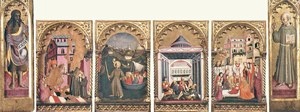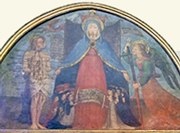Mariano di Antonio di Antonio di Nutolo trained under Pellegrino di Giovanni. When the latter died in 1437, Mariano inherited his workshop. He is documented in Rome in 1445.
Perugia
Altarpiece of the Blessed Giles (ca. 1439)
This altarpiece, which is attributed to Mariano di Antonio, was commissioned in ca. 1439 for the new altar of the shrine of the Blessed Giles in San Francesco al Prato. According to tradition, it was painted on the wooden panel upon which Giles’ body had been carried for burial from his hermitage on the site that later became the Convento di Monteripido to San Francesco al Prato.
The altarpiece was replaced on the altar and moved to the sacristy in ca. 1513. It was removed from the church in 1863, and was already damaged when it entered the Galleria Nazionale in 1872. It suffered further during its stay in the Convento di Monteripido in the period 1923-54.
The altarpiece depicts the Blessed Giles standing in a fictive aedicule, with three scenes from his life and posthumous miracles to each side. This format was consciously archaic and based on that of a number of panels that had been produced in the 13th century to celebrate the canonisation of St Francis. One of the better-preserved narrative scenes, which depicts a miracle occurring beside the sarcophagus shortly after Giles had died, is important for our understanding of the original arrangement of the cult site.
Panels from a polyptych (ca. 1455)

A document dated 1455 records a payment by Giovanni Montesperelli to Mariano di Antonio for a Maestà (now lost) that he had commissioned for his chapel in San Francesco al Prato. It is possible that this work was part of a polyptych that also included six panels attributed to Mariano di Antonio that were first recorded in 1810, when they were transferred from San Francesco al Prato to the Accademia di Belle Arti:
-
✴Four of the panels, which depict miracles of St Antony of Padua (to whom this chapel was dedicated), probably came from the predella; and
-
✴the other two, which depict SS John the Baptist and Bernardino of Siena, probably came from the pilasters. The fact that St Bernardino, who was canonised in 1450, is depicted with a halo is consistent with this dating.
If these assumptions are correct, this is the only securely documented work by Mariano di Antonio.
The six panels are now in the Galleria Nazionale.
Scenes of the Passion (ca. 1455)

These three small panels, which are attributed to Mariano di Antonio, probably came from the predella of an altarpiece in San Francesco al Prato. The panels, which are now in the Galleria Nazionale, depict:
-
✴the road to Calvary;
-
✴the Crucifixion; and
-
✴the Deposition of Christ.
The first and the third of these panels were moved from the sacristy of San Francesco al Prato to the Accademia di Belle Arti in 1810 and the second was acquired in the market in 1865.
Annunciation (15th century)
This panel, which is now in the Musée Jacquemart-André, Paris, is attributed to Mariano d’ Antonio. It contains an important representation of the Palazzo dei Priori.
Madonna della Misericordia (15th century)

This detached and much repainted fresco from a lunette is now on the left wall of Santa Croce. Some authorities suggest that it was commissioned during the plague of 1429: others attribute it to Mariano d’ Antonio and/or Benedetto Bonfigli, which would suggest a date closer to the 1450s.
The fresco depicts the Virgin shielding the people of Perugia under her cloak, with St Sebastian on the left and an angel holding the sword of faith on the right, [while God the Father fulminates above]. Inscriptions in poetic Italian document an exchange between the Virgin and St Sebastian.
Return to Art in: Perugia.



